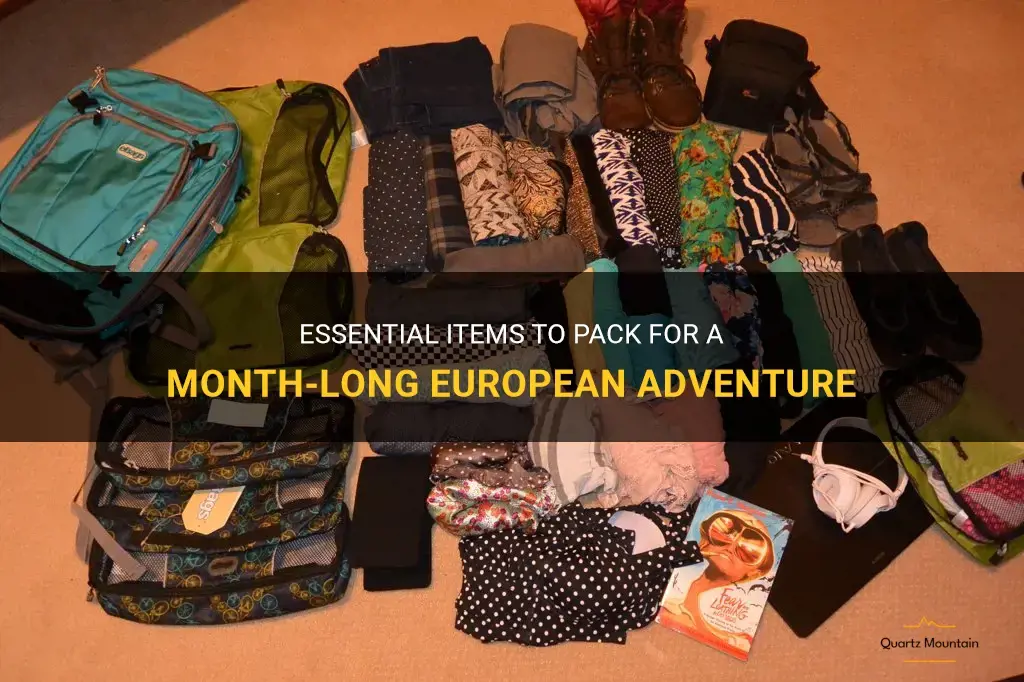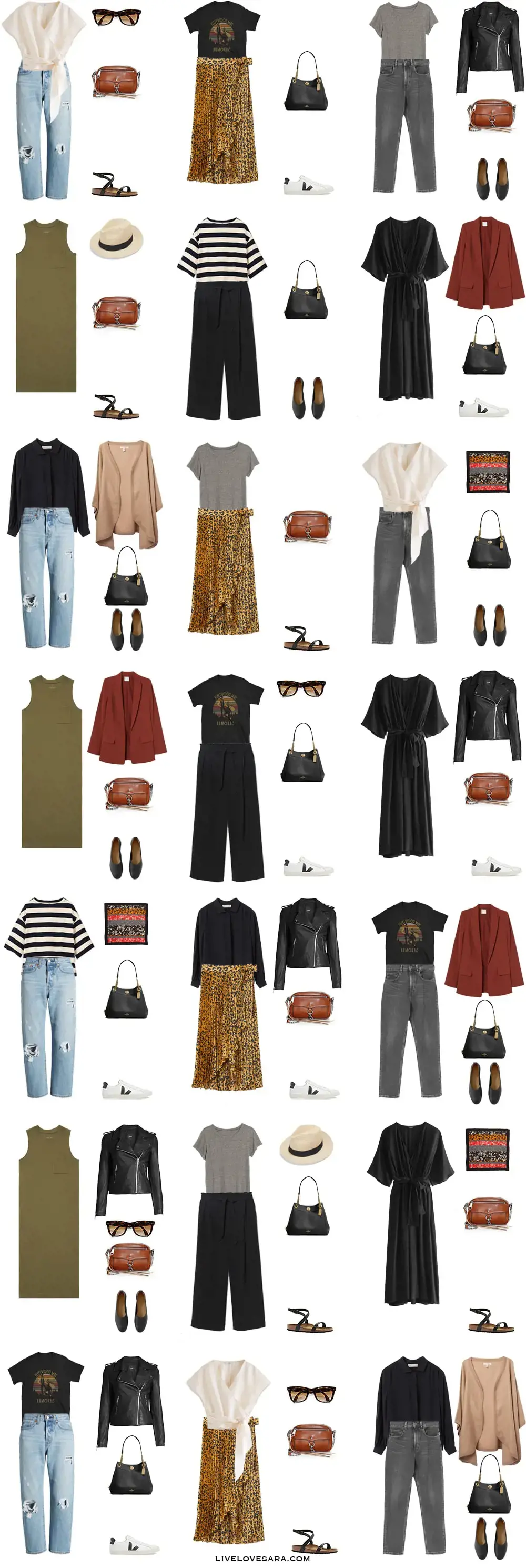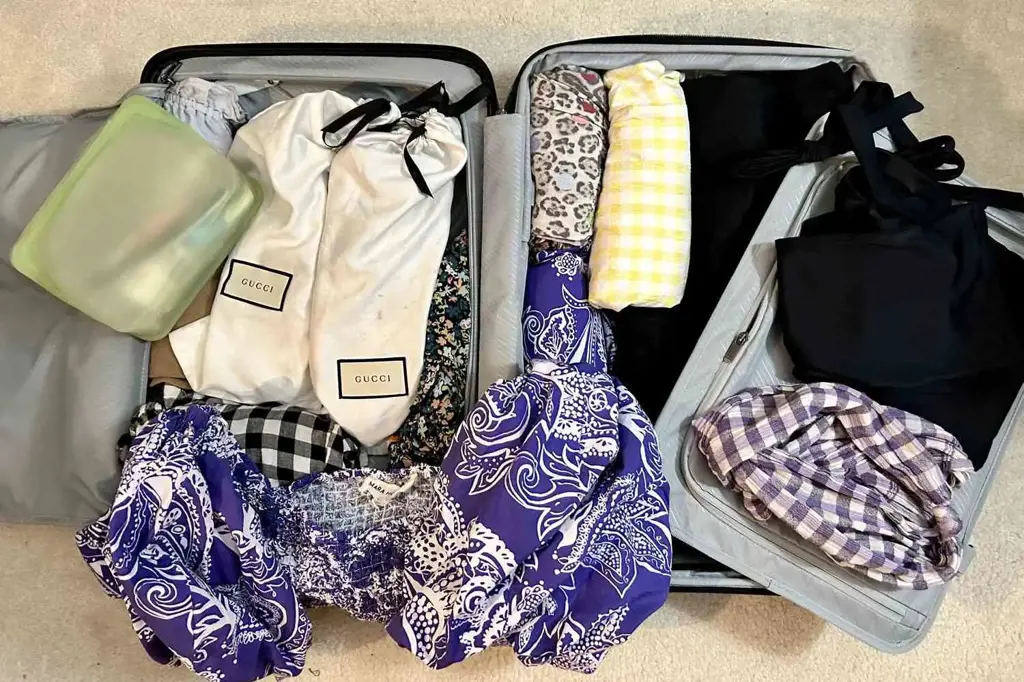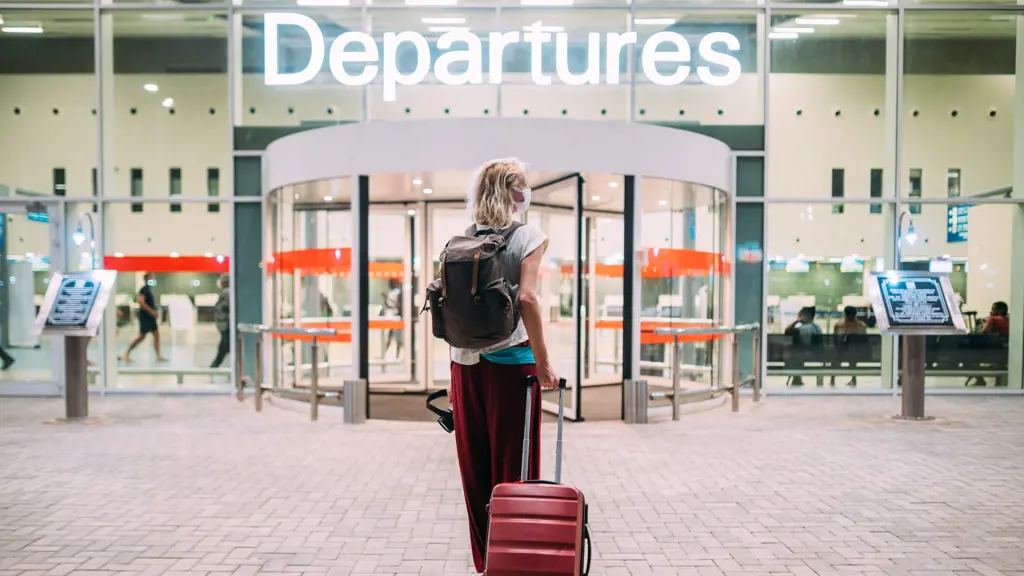
Are you planning a month-long European adventure? Well, congratulations on embarking on such an exciting journey! But before you get caught up in the excitement of exploring castles, indulging in delicious cuisine, and soaking up the rich cultural experiences Europe has to offer, it's important to make sure you have all the essential items packed in your bag. From travel adapters to comfortable shoes, this guide will help you stay prepared and make the most out of your European adventure without any hassle. So grab your passport and let's get packing!
What You'll Learn
- What are the essential clothing items to pack for a month-long trip to Europe?
- Are there any specific items that should be included in a packing list for different regions or climates of Europe?
- What kind of shoes are recommended for a month-long trip to Europe, considering both comfort and style?
- Are there any specific travel accessories that are necessary to pack for a month in Europe, such as power adapters, travel wallets, or portable chargers?
- How can I pack efficiently for a month-long trip to Europe and ensure that I have everything I need without overpacking?

What are the essential clothing items to pack for a month-long trip to Europe?

When preparing for a month-long trip to Europe, it's essential to pack clothing that is versatile, comfortable, and suitable for a variety of weather conditions. Here are some essential clothing items to consider for your trip:
- Comfortable walking shoes: Europe is known for its beautiful cities, historic sites, and charming cobblestone streets. To ensure you can explore these destinations comfortably, pack a pair of sturdy walking shoes. Look for shoes with good arch support and cushioning to protect your feet during long days of sightseeing.
- Layering pieces: Europe's weather can be unpredictable, so it's important to pack clothing that can be easily layered. Opt for lightweight sweaters, cardigans, and jackets that can be worn over t-shirts or long-sleeve tops. This way, you can add or remove layers as the temperature changes throughout the day.
- Versatile bottoms: Pack a mix of bottoms that can be dressed up or down depending on the occasion. Consider packing a couple of pairs of jeans or trousers that can be paired with both casual t-shirts and dressier blouses. Also, include a skirt or dress that can be dressed up with accessories for a night out.
- Breathable fabrics: Europe can get quite hot during the summer months, so it's important to choose clothing made from breathable fabrics like cotton or linen. These fabrics will help you stay cool and comfortable, especially if you're visiting southern European countries where temperatures can soar.
- Scarves and accessories: Scarves are a must-pack item for a trip to Europe. They can be used to add a pop of color to your outfits or keep you warm on chilly evenings. Additionally, don't forget to pack some versatile accessories like statement necklaces or earrings to elevate your outfits without taking up too much space in your luggage.
- Swimwear: If you're planning to visit destinations with beaches or pools, don't forget to pack your swimwear. Even if you're not planning to swim, having a swimsuit can come in handy for visiting thermal baths or enjoying spa facilities.
- Active wear: If you're planning to engage in outdoor activities such as hiking or cycling, pack some active wear. Include comfortable shorts, leggings, or moisture-wicking tops that will keep you comfortable during your adventures.
- Undergarments and socks: Don't forget to pack enough undergarments and socks to last you for the duration of your trip. Consider packing a few extra pairs in case you're not able to do laundry as frequently as you'd like.
Remember, it's important to pack light and choose clothing items that can be mixed and matched to create multiple outfits. By selecting versatile pieces that suit the local weather and activities, you'll be prepared for anything your month-long trip to Europe has in store. Pack smart, travel light, and enjoy your European adventure!
Essential Items to Pack for a Memorable Trip to Namibia
You may want to see also

Are there any specific items that should be included in a packing list for different regions or climates of Europe?

When preparing for a trip to Europe, it's important to consider the specific region or climate you will be visiting. Europe has a diverse range of climates, from the cold and snowy regions of Scandinavia to the hot and sunny Mediterranean coast. Each climate requires different clothing and gear to ensure you are comfortable and prepared for your trip. Here are some specific items that should be included in a packing list for different regions or climates of Europe.
Cold and snowy regions:
If you're planning to visit countries like Sweden, Norway, or Finland during the winter months, it's important to pack warm clothing and accessories. Some essential items include:
- Insulated winter jacket: Look for a jacket that is waterproof, windproof, and insulated to provide maximum warmth.
- Thermal layers: Pack thermal shirts, long johns, and socks to wear underneath your regular clothing for added warmth.
- Woolen hats and scarves: These will help keep your head and neck warm in freezing temperatures.
- Snow boots: Invest in a sturdy pair of waterproof and insulated snow boots to keep your feet dry and warm.
- Gloves: Look for gloves that are waterproof and insulated to protect your hands from the cold and snow.
Mild and rainy regions:
If you're traveling to countries like the United Kingdom or Netherlands, where the weather is generally mild with frequent rainfall, it's important to pack clothing that will keep you dry and comfortable. Consider the following items:
- Waterproof jacket: Look for a lightweight and breathable rain jacket that will keep you dry during showers.
- Rain boots: Pack a pair of rain boots to keep your feet dry while exploring wet and muddy areas.
- Umbrella: Carry a compact and sturdy umbrella to shield yourself from the rain.
- Quick-drying clothing: Opt for quick-drying materials like nylon or polyester that will dry quickly if they get wet.
Hot and sunny regions:
If you're planning a trip to countries like Spain, Italy, or Greece during the summer, it's crucial to pack light and breathable clothing to stay cool in the heat. Consider the following items:
- Sunscreen: Protect your skin from the sun's harmful rays by packing a high SPF sunscreen.
- Sunglasses: Invest in a pair of sunglasses to protect your eyes from the bright sunlight.
- Lightweight clothing: Pack lightweight and breathable materials like cotton or linen to stay cool in hot temperatures.
- Hat: Carry a wide-brimmed hat to shield your face and neck from the sun.
- Swimsuit: If you plan on hitting the beaches or swimming in lakes, don't forget to pack a swimsuit.
While these are some general recommendations, it's also important to research the specific weather conditions of the region you will be visiting. This will help you tailor your packing list to the specific climate and ensure you have the necessary items to stay comfortable during your trip.
In conclusion, packing for different regions or climates in Europe requires careful consideration of the weather conditions. Whether you're visiting a cold and snowy region, a mild and rainy region, or a hot and sunny region, packing the right clothing and gear will ensure you have a comfortable and enjoyable trip. Use this guide as a starting point and adjust it based on the specific weather conditions of your destination.
Essential Items to Pack for Hot Humid Weather
You may want to see also

What kind of shoes are recommended for a month-long trip to Europe, considering both comfort and style?

When embarking on a month-long trip to Europe, it is essential to pack comfortable and stylish shoes that can withstand a variety of activities and terrains. Exploring the narrow streets of historic towns, hiking through picturesque landscapes, and visiting cultural landmarks all require shoes that prioritize both comfort and style. To ensure a successful trip, consider the following factors when selecting the ideal pair of shoes for your European adventure.
- Comfort should be the top priority when choosing travel footwear. Prepare for long days of walking by selecting shoes with ample cushioning and support. Look for shoes with a well-padded insole and arch support to prevent foot fatigue and minimize the risk of developing blisters. Additionally, opt for shoes that are breathable to keep your feet dry and comfortable, even in warm weather.
- Choose shoes that are versatile and suitable for various activities. Europe offers a wide range of experiences, from exploring city streets to hiking in the mountains. Select shoes that can easily transition from day to night, allowing you to explore during the day and go out for a nice dinner in the evening. Slip-on sneakers, loafers, or ankle boots are all excellent choices that can be dressed up or down as needed.
- Consider the climate and weather conditions of the countries you will be visiting. If you are traveling during the summer, opt for lightweight and breathable shoes to keep your feet cool. In colder months, invest in waterproof and insulated shoes to keep your feet warm and dry. Weather-appropriate footwear will ensure that you are ready to explore, rain or shine.
- Pay attention to the fit of the shoes. Shoes that are too loose or too tight can cause discomfort and potentially lead to foot-related issues. When trying on shoes, ensure that there is enough room in the toe box for your toes to wiggle comfortably. Walk around in the shoes to test their stability and make sure they do not rub or pinch any part of your feet.
- Break in your shoes before your trip. It is important to wear your shoes for a few weeks before your journey to allow time for them to conform to your feet and prevent any potential discomfort. This will also give you an opportunity to test their durability and make sure they are suitable for your needs.
Example: If you plan on exploring cities such as Paris or Rome, where you will be on your feet for extended periods, a pair of comfortable walking shoes or sneakers would be an excellent choice. On the other hand, if your itinerary includes hiking in the Swiss Alps or exploring the Scottish Highlands, investing in a sturdy pair of hiking boots would be a wise decision.
Investing in high-quality, comfortable, and stylish shoes is essential for a month-long trip to Europe. By considering factors such as comfort, versatility, climate, fit, and breaking in the shoes, you can ensure that your footwear will support you throughout your journey and enhance your overall travel experience. So, pack your favorite pair of shoes and get ready to explore the wonders of Europe in style and comfort!
The Ultimate Guide to Packing for a Royal Caribbean Cruise: PDF Checklist for Stress-Free Travel
You may want to see also

Are there any specific travel accessories that are necessary to pack for a month in Europe, such as power adapters, travel wallets, or portable chargers?

When embarking on a month-long trip to Europe, it is essential to pack the right travel accessories to ensure a smooth and hassle-free journey. While some items may seem obvious, there are a few specific accessories that are necessary to enhance your travel experience. This article will outline the must-have essentials for a month-long trip to Europe, including power adapters, travel wallets, and portable chargers.
Power adapters are a crucial accessory that should never be overlooked when traveling to Europe. The continent uses different types of power outlets and voltage standards compared to other parts of the world. Therefore, without a power adapter, you will not be able to charge your electronic devices or use any electrical appliances. It is advisable to invest in a universal adapter that can be used in multiple countries to ensure compatibility no matter where you go.
Travel wallets are another essential accessory for a trip to Europe. With so many important documents to keep track of, such as passports, visas, travel insurance, and various cards, having a secure and organized wallet is paramount. Look for a travel wallet with multiple compartments and RFID-blocking technology to protect sensitive information from being stolen. Additionally, opt for a compact wallet that can easily fit in your pocket or bag, making it convenient to carry around during your travels.
In today's digital world, staying connected is crucial, and having a portable charger will ensure your devices never run out of power. Between navigating through unfamiliar cities using maps and translation apps, capturing memorable moments with your camera or phone, and staying in touch with friends and family, your devices will be put to good use. A portable charger allows you to charge your devices on the go, regardless of whether you have access to a power outlet. Look for one with a high capacity to ensure you have enough power to last throughout the day.
In addition to these specific travel accessories, there are a few other items that are worth considering for a month-long trip to Europe. First, a sturdy and reliable luggage lock is essential to keep your belongings safe. Europe's crowded tourist areas are prime targets for pickpockets, and having a lock on your bag adds an extra layer of security. Second, a lightweight and compact travel towel is a handy item to have, especially if you plan on staying in hostels or budget accommodations where towels may not be provided. Finally, a compact umbrella can come in handy during unexpected rain showers, especially if you are traveling during the shoulder seasons.
To summarize, when packing for a month-long trip to Europe, it is necessary to include specific travel accessories such as power adapters, travel wallets, and portable chargers. These items will ensure you can stay connected, keep your important documents secure, and always have power for your electronic devices. Additionally, considering other items such as a luggage lock, travel towel, and compact umbrella can further enhance your travel experience. By being well-prepared with the right accessories, you can make the most of your trip to Europe and have a stress-free journey.
Essential Tips for Packing Two Months Before Your Move
You may want to see also

How can I pack efficiently for a month-long trip to Europe and ensure that I have everything I need without overpacking?

Preparing for a month-long trip to Europe can be both exciting and daunting. You want to make sure you have everything you need without going overboard on packing. Here are some scientific and practical tips to help you pack efficiently for your trip:
- Check the weather: Before you start packing, research the weather conditions in the cities you will be visiting. This will help you determine what type of clothing you need to bring. Pack versatile items that can be layered for different temperature variations.
- Make a packing list: Creating a packing list is a crucial step to ensure you have everything you need and avoid overpacking. Start by writing down essential items like clothing, toiletries, electronics, and travel documents. Consult online resources or travel guides for specific recommendations.
- Use a packing system: Invest in packing cubes or compression bags to organize your belongings efficiently. These can help save space in your luggage and keep your items neatly separated. Separate your clothing into categories, such as tops, bottoms, and undergarments for easy access.
- Mix and match clothing: Instead of packing a different outfit for each day, prioritize versatile pieces that can be mixed and matched. Choose clothing in neutral colors that can be easily layered or accessorized. This will allow you to create multiple outfits without bringing excessive items.
- Consider laundry options: If you will have access to laundry facilities during your trip, pack fewer clothes and plan to do laundry regularly. This will save space in your luggage and give you the freedom to repeat outfits without worry. Pack a small amount of detergent or invest in travel-sized laundry products.
- Choose travel-sized toiletries: Toiletries can quickly take up space in your luggage, so opt for travel-sized products or transfer your essentials into smaller containers. Consider purchasing items like toothpaste, shampoo, and sunscreen at your destination to lighten your load.
- Wear bulky items during travel: Instead of packing bulky items like jackets or boots, wear them during your travel days. This not only saves space in your luggage but also helps keep you comfortable during your journey.
- Use vacuum bags: For items like jackets or sweaters that cannot be worn during travel, use vacuum bags to compress them. These bags remove excess air and significantly reduce the volume of your clothing, allowing you to pack more efficiently.
- Minimize electronics: Evaluate your electronic needs and try to limit the number of devices you bring. Do you really need a laptop, tablet, and smartphone? Consider whether you can manage with just your smartphone for most tasks.
- Pack a versatile daypack: A lightweight, versatile daypack is essential for day trips and excursions. Choose one that can be easily folded and packed inside your main luggage when not in use.
By following these scientific and practical tips, you can pack efficiently for your month-long trip to Europe. Remember to prioritize versatility and consider your specific needs to avoid overpacking. Happy travels!
Essential Tips for Packing and Dressing for Your Trip to London
You may want to see also
Frequently asked questions
It's important to pack versatile clothing that can be layered, as the weather can vary greatly across different European countries during any given month. Bring items such as jeans, t-shirts, sweaters, and a light jacket. Also, make sure to pack comfortable walking shoes for exploring cities and tourist sites.
It's always a good idea to have a slightly more formal outfit on hand, especially if you plan on dining at nicer restaurants or attending any events that require a dress code. You can pack a nice dress or a pair of slacks and a blouse for such occasions.
If you plan on visiting coastal areas, islands, or staying at hotels with pools, it's a good idea to pack a swimsuit. Europe has many beautiful beaches and swimming spots, especially in countries like Spain, Italy, and Greece. Just make sure to check the weather and the itinerary of your trip to ensure you'll have the opportunity to swim.
Europe uses a different type of electrical outlet and voltage than countries in other regions, such as the United States. So, it's important to pack a universal adapter or one specifically for European outlets. This will allow you to charge your electronics and use any electrical devices you bring along.
Consider packing a small daypack or tote bag for carrying essentials while exploring. Other essentials include a travel-sized toiletry kit, medications, a travel umbrella, a reusable water bottle, a portable charger, and any necessary travel documents (such as a passport and travel insurance information). It's also a good idea to research the specific countries you'll be visiting to see if there are any additional items you should pack.







